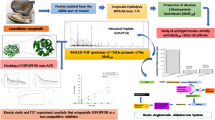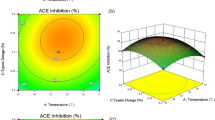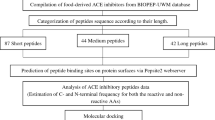Abstract
Pumpkin seed proteins with desirable nutritional properties have attracted great interest as an innovative source of bioactive peptides with beneficial effects in recent years. The current study aimed to screen novel ACE inhibitory peptides from pumpkin seed proteins by in silico approach and further elucidate the underlying inhibition mechanisms. A novel tripeptide, IAF (Ile-Ala-Phe) with acceptable bioavailability properties exhibited considerable ACE inhibitory ability with an IC50 of 19.87 ± 0.50 μM. Molecular docking study showed that IAF could bound with key residues in the active site of ACE. Further molecular dynamics (MD) simulation suggested that the simulation systems reached equilibrium after 5 ns and that ACE and IAF can form complex in stabilization. Moreover, MD analysis revealed that the hydrogen bonds interactions between IAF and two key residues (His513 and Glu162) of ACE and the chelation between O3 atom of IAF and Zn2+ play more important roles in the stabilization for ACE–IAF complex, which might contribute significantly to the ACE inhibitory activity. Our study indicated that the novel and potential ACE inhibitory peptide IAF from pumpkin seed proteins can be considered as a promising candidate for controlling hypertension.





Similar content being viewed by others
Abbreviations
- ACE:
-
Angiotensin-converting enzyme
- ADME:
-
Absorption, distribution, metabolism, and elimination
- FAPGG:
-
N-[3-(2-furyl)acryloyl]-Phe-Gly-Gly
- LINCS:
-
Linear constraint solver
- MD:
-
Molecular dynamic
- MOE:
-
Molecular operating environment
- PME:
-
Particle mesh Ewald
- RMSD:
-
Root mean square deviation
- RMSF:
-
Root mean square fluctuation
- Rg:
-
Radius of gyration
- SASA:
-
Solvent-accessible surface area
References
Venuste M, Zhang X, Shoemaker CF et al (2013) Influence of enzymatic hydrolysis and enzyme type on the nutritional and antioxidant properties of pumpkin meal hydrolysates. Food Funct 4:811–820. https://doi.org/10.1039/c3fo30347k
Vaštag Ž, Popović L, Popović S et al (2011) Production of enzymatic hydrolysates with antioxidant and angiotensin-I converting enzyme inhibitory activity from pumpkin oil cake protein isolate. Food Chem 124:1316–1321. https://doi.org/10.1016/j.foodchem.2010.07.062
Xia HC, Li F, Li Z, Zhang ZC (2003) Purification and characterization of Moschatin, a novel type I ribosome-inactivating protein from the mature seeds of pumpkin (Cucurbita moschata), and preparation of its immunotoxin against human melanoma cells. Cell Res 13:369–374. https://doi.org/10.1038/sj.cr.7290182
Caili F, Huan S, Quanhong L (2006) A review on pharmacological activities and utilization technologies of pumpkin. Plant Foods Hum Nutr 61:73–80. https://doi.org/10.1007/s11130-006-0016-6
Ozuna C, León-Galván MF (2017) Cucurbitaceae seed protein hydrolysates as a potential source of bioactive peptides with functional properties. Biomed Res Int 2017:2121878. https://doi.org/10.1155/2017/2121878
Vinayashree S, Vasu P (2021) Biochemical, nutritional and functional properties of protein isolate and fractions from pumpkin (Cucurbita moschata var Kashi Harit) seeds. Food Chem 340:128177. https://doi.org/10.1016/j.foodchem.2020.128177
Miralles B, Amigo L, Recio I (2018) Critical review and perspectives on food-derived antihypertensive peptides. J Agric Food Chem 66:9384–9390. https://doi.org/10.1021/acs.jafc.8b02603
Tacias-Pascacio VG, Morellon-Sterling R, Siar EH et al (2020) Use of alcalase in the production of bioactive peptides: a review. Int J Biol Macromol 165:2143–2196. https://doi.org/10.1016/j.ijbiomac.2020.10.060
Bučko S, Katona J, Popović L et al (2016) Influence of enzymatic hydrolysis on solubility, interfacial and emulsifying properties of pumpkin (Cucurbita pepo) seed protein isolate. Food Hydrocoll 60:271–278. https://doi.org/10.1016/j.foodhyd.2016.04.005
Han R, Maycock J, Murray BS, Boesch C (2019) Identification of angiotensin converting enzyme and dipeptidyl peptidase-IV inhibitory peptides derived from oilseed proteins using two integrated bioinformatic approaches. Food Res Int 115:283–291. https://doi.org/10.1016/j.foodres.2018.12.015
Iwaniak A, Darewicz M, Mogut D, Minkiewicz P (2019) Elucidation of the role of in silico methodologies in approaches to studying bioactive peptides derived from foods. J Funct Foods 61:103486. https://doi.org/10.1016/j.jff.2019.103486
Minkiewicz P, Iwaniak A, Darewicz M (2019) BIOPEP-UWM database of bioactive peptides: current opportunities. Int J Mol Sci 20:5978. https://doi.org/10.3390/ijms20235978
Pooja K, Rani S, Prakash B (2017) In silico approaches towards the exploration of rice bran proteins-derived angiotensin-I-converting enzyme inhibitory peptides. Int J Food Prop 20:2178–2191. https://doi.org/10.1080/10942912.2017.1368552
Fitzgerald RJ, Cermeño M, Khalesi M et al (2020) Application of in silico approaches for the generation of milk protein-derived bioactive peptides. J Funct Foods 64:103636. https://doi.org/10.1016/j.jff.2019.103636
Guo H, Richel A, Hao Y et al (2020) Novel dipeptidyl peptidase-IV and angiotensin-I-converting enzyme inhibitory peptides released from quinoa protein by in silico proteolysis. Food Sci Nutr 8:1415–1422. https://doi.org/10.1002/fsn3.1423
Uraipong C, Zhao J (2016) Rice bran protein hydrolysates exhibit strong in vitro α-amylase, β-glucosidase and ACE-inhibition activities. J Sci Food Agric 96:1101–1110. https://doi.org/10.1002/jsfa.7182
Jiang Z, Zhang H, Bian X et al (2019) Insight into the binding of ACE-inhibitory peptides to angiotensin-converting enzyme: a molecular simulation. Mol Simul 45:215–222. https://doi.org/10.1080/08927022.2018.1557327
Mazloomi SN, Sadeghi-Mahoonak A, Ranjbar-Nedamani E, Nourmohammadi E (2019) Production of antioxidant peptides through hydrolysis of paper skin pumpkin seed protein using pepsin enzyme and the evaluation of their functional and nutritional properties. ARYA Atheroscler 15:218–227. https://doi.org/10.22122/arya.v15i5.1755
Vaštag Ž, Popović L, Popović S et al (2013) In vitro study on digestion of pumpkin oil cake protein hydrolysate: evaluation of impact on bioactive properties. Int J Food Sci Nutr 64:452–460. https://doi.org/10.3109/09637486.2012.749837
Iwaniak A, Minkiewicz P, Pliszka M et al (2020) Characteristics of biopeptides released in silico from collagens using quantitative parameters. Foods 9:1–29. https://doi.org/10.3390/foods9070965
Shen W, Matsui T (2017) Current knowledge of intestinal absorption of bioactive peptides. Food Funct 8:4306–4314. https://doi.org/10.1039/C7FO01185G
Meng L, Feng K, Ren Y (2018) Molecular modelling studies of tricyclic triazinone analogues as potential PKC-θ inhibitors through combined QSAR, molecular docking and molecular dynamics simulations techniques. J Taiwan Inst Chem Eng 91:155–175. https://doi.org/10.1016/j.jtice.2018.06.017
Abdelhedi O, Nasri M (2019) Basic and recent advances in marine antihypertensive peptides: production, structure-activity relationship and bioavailability. Trends Food Sci Technol 88:543–557. https://doi.org/10.1016/j.tifs.2019.04.002
Daina A, Zoete V (2016) A boiled-egg to predict gastrointestinal absorption and brain penetration of small molecules. ChemMedChem 11:1117
Gianfranceschi GL, Gianfranceschi G, Quassinti L, Bramucci M (2018) Biochemical requirements of bioactive peptides for nutraceutical efficacy. J Funct Foods 47:252–263. https://doi.org/10.1016/j.jff.2018.05.034
Zhu X-L, Watanabe K, Shiraishi K et al (2008) Identification of ACE-inhibitory peptides in salt-free soy sauce that are transportable across caco-2 cell monolayers. Peptides 29:338–344. https://doi.org/10.1016/j.peptides.2007.11.006
Zheng Y, Li Y, Zhang Y et al (2017) Purification, characterization, synthesis, in vitro ACE inhibition and in vivo antihypertensive activity of bioactive peptides derived from oil palm kernel glutelin-2 hydrolysates. J Funct Foods 28:48–58. https://doi.org/10.1016/j.jff.2016.11.021
Balti R, Nedjar-Arroume N, Adjé EY et al (2010) Analysis of novel angiotensin I-converting enzyme inhibitory peptides from enzymatic hydrolysates of cuttlefish (Sepia officinalis) muscle proteins. J Agric Food Chem 58:3840–3846. https://doi.org/10.1021/jf904300q
Yu Z, Wang L, Wu S et al (2021) In vivo anti-hypertensive effect of peptides from egg white and its molecular mechanism with ACE. Int J Food Sci Technol 56:1030–1039. https://doi.org/10.1111/ijfs.14756
Qi C, Zhang R, Liu F et al (2017) Molecular mechanism of interactions between inhibitory tripeptide GEF and angiotensin-converting enzyme in aqueous solutions by molecular dynamic simulations. J Mol Liq 249:389–396
Nawaz KAA, David SM, Murugesh E et al (2017) Identification and in silico characterization of a novel peptide inhibitor of angiotensin converting enzyme from pigeon pea (Cajanus cajan). Phytomedicine 36:1–7. https://doi.org/10.1016/j.phymed.2017.09.013
Desheng L, Jian G, Yuanhua C et al (2011) Molecular dynamics simulations and MM/GBSA methods to investigate binding mechanisms of aminomethylpyrimidine inhibitors with DPP-IV. Bioorg Med Chem Lett 21:6630–6635
Aiemratchanee P, Panyawechamontri K, Phaophu P et al (2020) In vitro antihypertensive activity of bioactive peptides derived from porcine blood corpuscle and plasma proteins. Int J Food Sci Technol. https://doi.org/10.1111/ijfs.14853
Shi A, Liu H, Liu L et al (2014) Isolation, purification and molecular mechanism of a peanut protein-derived ACE-inhibitory peptide. PLoS ONE 9:23–25. https://doi.org/10.1371/journal.pone.0111188
Wang X, Wu S, Xu D et al (2011) Inhibitor and substrate binding by angiotensin-converting enzyme: quantum mechanical/molecular mechanical molecular dynamics studies. J Chem Inf Model 51:1074–1082
Jalkute CB, Barage SH, Dhanavade MJ, Sonawane KD (2013) Molecular dynamics simulation and molecular docking studies of angiotensin converting enzyme with inhibitor lisinopril and amyloid beta peptide. Protein J 32:356–364. https://doi.org/10.1007/s10930-013-9492-3
Natesh R, Schwager SLU, Evans HR et al (2004) Structural details on the binding of antihypertensive drugs captopril and enalaprilat to human testicular angiotensin I-converting enzyme. Biochemistry 43:8718
Funding
This work was supported by [National Natural Science Foundation of China] (Grant number 32001702).
Author information
Authors and Affiliations
Corresponding author
Ethics declarations
Conflict of interest
The authors have no relevant financial or non-financial interests to disclose.
Compliance with ethics requirements
This study does not contain any studies with human participants or animals performed by any of the authors.
Additional information
Publisher's Note
Springer Nature remains neutral with regard to jurisdictional claims in published maps and institutional affiliations.
Supplementary Information
Below is the link to the electronic supplementary material.
Rights and permissions
About this article
Cite this article
Liang, F., Shi, Y., Shi, J. et al. A novel Angiotensin-I-converting enzyme (ACE) inhibitory peptide IAF (Ile-Ala-Phe) from pumpkin seed proteins: in silico screening, inhibitory activity, and molecular mechanisms. Eur Food Res Technol 247, 2227–2237 (2021). https://doi.org/10.1007/s00217-021-03783-1
Received:
Revised:
Accepted:
Published:
Issue Date:
DOI: https://doi.org/10.1007/s00217-021-03783-1




